Entrepreneurs, innovators, trailblazers – these are people who question established ways and relish the challenges of new directions, who lead the way in shaping societies for the future.
Issue information
For a relatively small country, New Zealand has an impressive list of achievements to its name – a reflection of our history as a country of pioneers with a ‘can do’ attitude that insists there are no such things as problems; merely solutions.
Leading the Way, the fifth in a series of stamps leading up to the new millennium, captured some of New Zealand’s defining moments, and the people who made them possible.
In 1893, New Zealand was the first country in the world to introduce the vote for women, and almost a century later the first to declare itself 'nuclear free'. In 1919, Lord Ernest Rutherford reshaped the future by finding a way to split the atom. New Zealander Richard Pearse may well have been the first to achieve powered flight in 1903, while travel on the water took on a whole new meaning with Bill Hamilton's invention of the jet boat in 1953. And who can forget Sir Edmund Hillary's conquest of Mount Everest in that same year?
As we approached the new century - it was time to celebrate and acknowledge those ground breaking New Zealanders.
Product Listing for Leading the Way - The Millennium Series Part Five
| Image | Title | Description | Price |
|---|---|---|---|
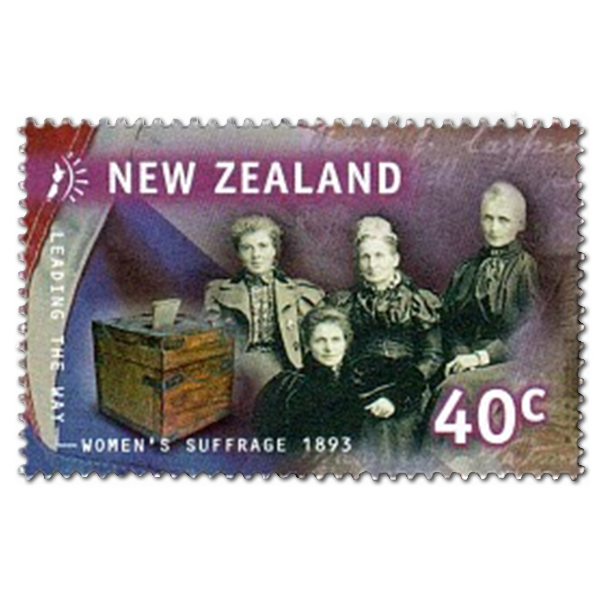 |
Single Stamp |
Single 40c 'Women’s Suffrage, 1893' gummed stamp. The first women’s franchise bill was introduced into the New Zealand Parliament in 1877. It was rejected – just like similar bills that would be introduced over the next decade. Throughout 1892 Kate Sheppard, national superintendent of the Women’s Christian Temperance Union’s Franchise Department and suffragists throughout the country intensified the pressure for change, through leaflets, articles, public meetings and direct lobbying of politicians. By the following year, suffrage had gained widespread support. A third petition – 300 yards long and containing the signatures of nearly 32,000 women – resulted in an electoral bill giving women the right to vote being passed on 8 September. The Electoral Act 1893 was passed 11 days later, making New Zealand the first country in the world to inaugurate universal female suffrage. |
$0.40 |
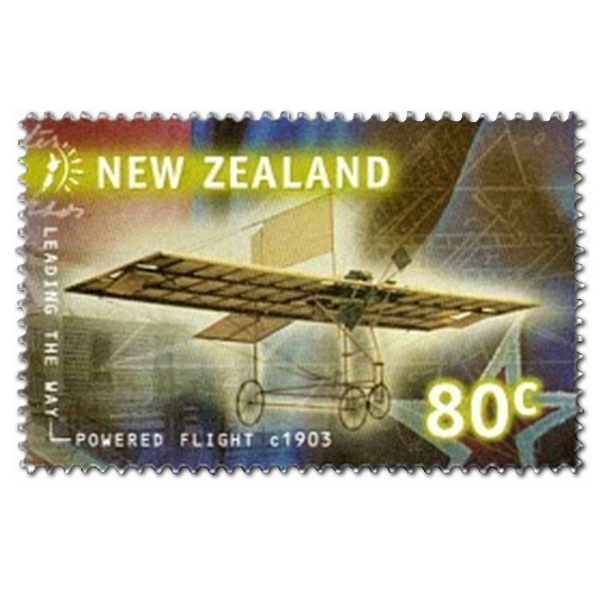 |
Single Stamp |
Single 80c 'Powered Flight, c1903' gummed stamp. The first recognised flight by a heavier-than-air machine was that undertaken by the Wright Brothers in Flier 1 on 17 December 1903. However, around 31 March 1903 – almost a year before the Wright brothers’ celebrated flight at Kittyhawke in North Carolina – a young New Zealander, Richard Pearse, is said to have lifted into the air in a high wing monoplane of his own design. Only he, his brother and a few locals were witness to this event. There were no photographs, no reports in local newspapers, nothing to record the event – largely because the solitary and reclusive inventor had no interest in letting anyone know – so no documentary or conclusive proof of any kind exists to verify the timing of the first flight. |
$0.80 |
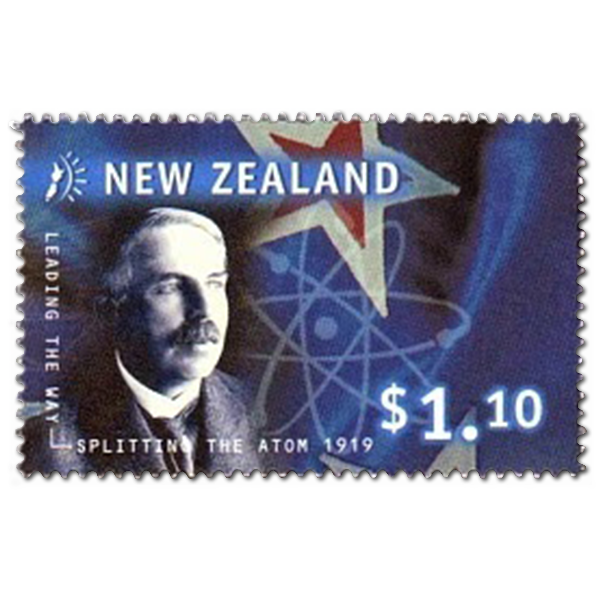 |
Single Stamp |
Single $1.10 'Splitting the Atom, 1919' gummed stamp. Ernest Rutherford – or Lord Rutherford as he would later become - was the greatest physicist of his time; a man known as ‘the father of nuclear physics’ and regarded by Einstein as "one of the greatest experimental scientists of all time". Rutherford is known for his studies of radioactivity and the discovery of the atomic nucleus. He discovered and named alpha and beta radiation, and, along with Fredrick Soddy, proposed a theory of radioactive transformation of atoms for which he received the 1908 Nobel Prize in Chemistry. In 1911, he proposed a new structure for the atom, imagining it as a small, heavy nucleus surrounded by orbital electrons. This nuclear model of the atom, along with the quantum theory, would provide the basic description of the atom still accepted today. Rutherford also produced hydrogen by bombarding atoms of various elements with helium nuclei (alpha rays). These findings, published in 1919, were the first evidence of an ability to artificially produce splitting of atomic nuclei. |
$1.10 |
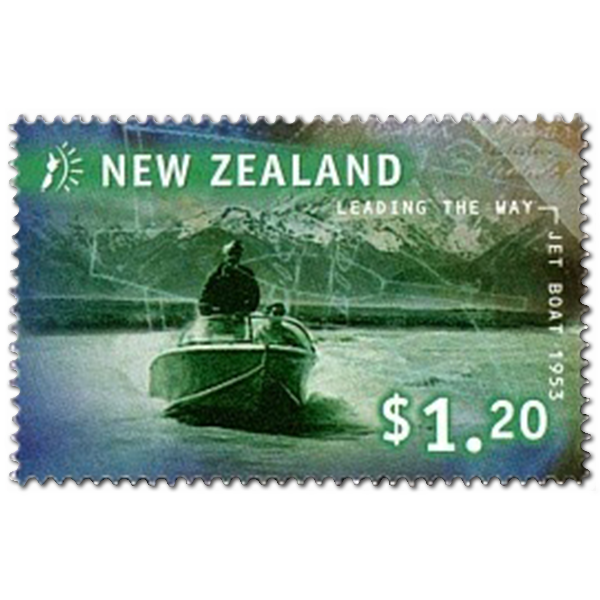 |
Single Stamp |
Single $1.20 'Jet Boat, 1953' gummed stamp. Though he was often attributed with the invention of the jet boat, Bill Hamilton (1899 – 1978) himself never made such a claim. Indeed, in response to a critic in 1962, he said, "The honour for marine jet propulsion probably belongs to a gentleman named Archimedes who lived some years ago." The Greek physicist had in fact designed a primitive hard-driven screw to lift water from a well 250 years before the birth of Christ. British inventors also dabbled in jet-powered propulsion in the sixteenth, seventeenth and eighteenth centuries. By the 1890s, jets had been tested in a wide variety of low displacement craft, but with little success. What Bill Hamilton did, along with his team, was to successfully develop and perfect water jet propulsion to drive boats without propellers. |
$1.20 |
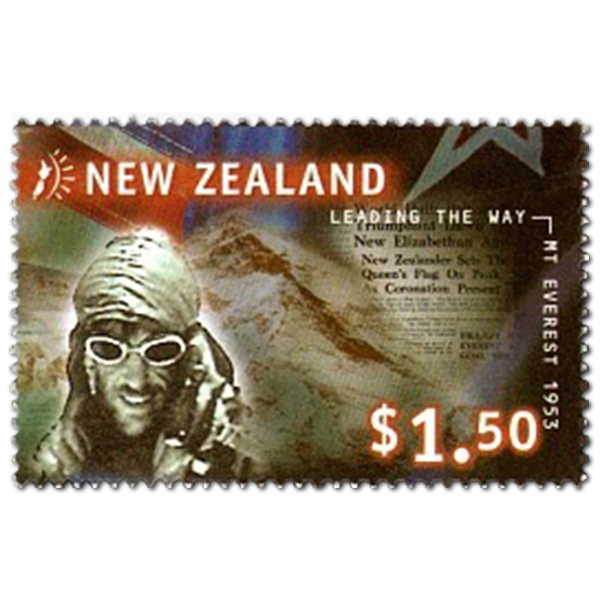 |
Single Stamp |
Single $1.50 'Conquest of Mount Everest, 1953' gummed stamp. Edmund Percival Hillary the man who would become New Zealand’s most famous and celebrated mountaineer was born in Auckland on 20 July 1919. Educated at Auckland Grammar School, he left school to become an apiarist. He returned to the profession after the War in partnership with his brother. Edmund Hillary’s overriding passion however was mountaineering, and having gained considerable experience climbing in his own land, he led the New Zealand Gawhal Expedition in 1951. Later the same year, he joined the British Everest Reconnaissance Expedition and, in 1952, the British Cho Oyu Expedition. In 1953, as a member of Sir John Hunt’s British Everest Expedition, he reached the summit of Mount Everest with Tenzing Norkay on 29 May. At just 33 years of age, Hillary was on top of the world – literally. He broke the news of the achievement with a famous one liner issued to another New Zealander on the expedition, George Lowe. "Well, we knocked the bastard off," he said. |
$1.50 |
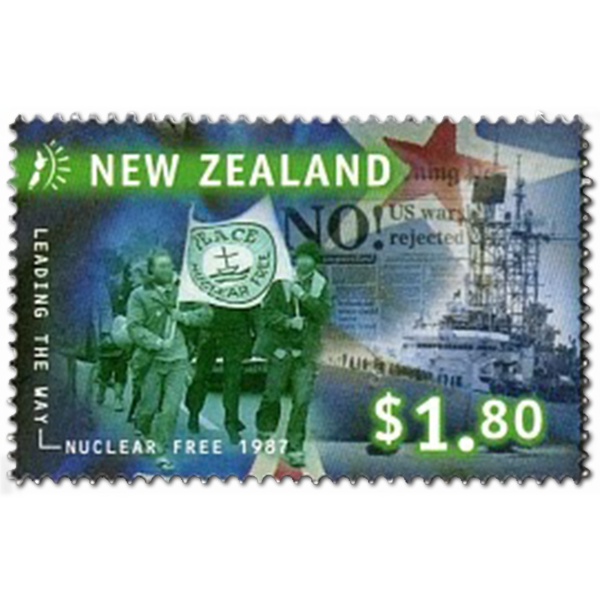 |
Single Stamp |
Single $1.80 'Nuclear Free New Zealand 1987' gummed stamp. The fourth Labour government’s harbour policy expressly prohibited visits by nuclear-powered or nuclear-armed ships of any country. The United States’ unwillingness to disclose the nuclear status of any member of their fleet led to the cancellation of a planned visit by the USS Buchanan in February 1985. New Zealand’s refusal to allow the ship to call at its ports resulted in a series of angry responses from Washington, which questioned New Zealand’s place and role in the ANZUS alliance. Resenting interference in what they saw as their own domestic politics, and buoyed by support from anti-nuclear supporters overseas, New Zealanders rallied behind the ‘no nukes’ cry. By the mid-1980s, nuclear-free status had become a matter of national importance and identity, inextricably linked with our right to formulate our own security policies for our particular circumstances. The New Zealand Nuclear Free Zone, Disarmament and Arms Control Act was passed in June 1987. It made New Zealand the first independent legally nuclear-free country in the world. |
$1.80 |
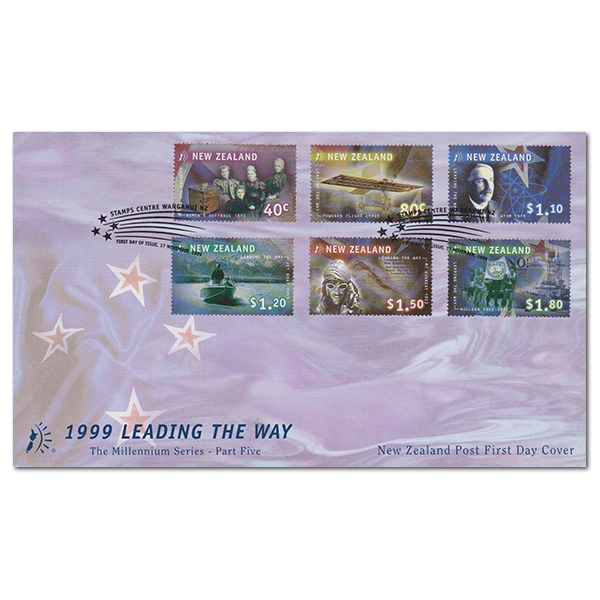 |
First Day Cover | First day cover with stamps affixed. Cancelled on the first day of issue. | $7.30 |
Technical information
| Date of issue: | 17 November 1999 |
|---|---|
| Number of stamps: | Six |
| Denominations and designs: | 40c Womans Suffrage, 1893; 80c Powered Flight, c1903; $1.10 Splitting the Aton, 1919; $1.20 Jet Boat, 1953; $1.50 Mt Everest, 1953; $1.80 Nuclear Free, 1987 |
| Stamps and first day cover designed by: | Deidre Cassell, Siren Communications, Wellington, New Zealand |
| Printer and process: | Southern Colour Print, New Zealand by lithography |
| Number of colours: | Four process colours |
| Stamp size and format: | 28mm x 44mm horizontal |
| Number of stamps per sheet: | 100 stamps per sheet |
| Perforation gauge: | 14 |
| Paper type: | 103 gsm red phosphor coated |
| Special blocks: | Plate/imprint blocks were obtained by purchasing at least six sheet stamps. Barcode and value blocks were obtained by purchasing at least two sheet stamps. Barcode blocks were available in both A and B formats. |
| Period of sale: | These stamps remained on sale until 16 November 2000. |

